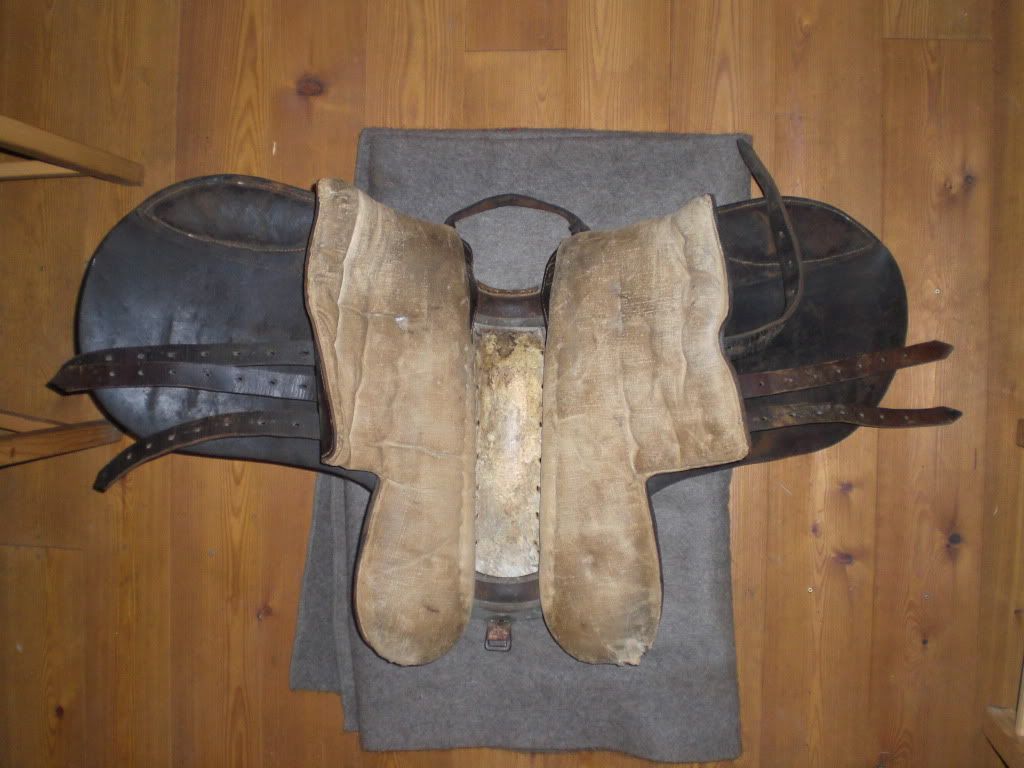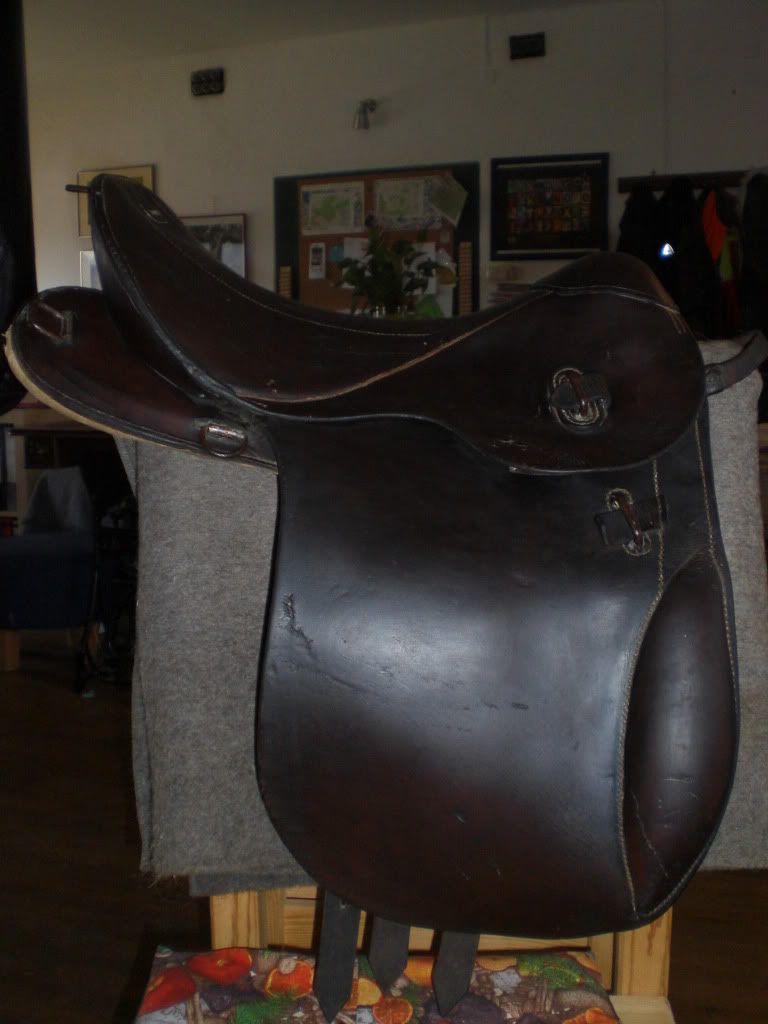Can anybody tell me what practical reason there was for cutting the horses tail? You can see it quite often that cavalry horses of that time period had their tails cut. German, British, Belgian and French Cavalry at least. Was it just a fancy thing? Seems odd to me considering the functions of the horses tail.
Tom
Armeesattels before the 25
-
Tom Muller
- Society Member
- Posts: 237
- Joined: Sun Jun 18, 2006 12:14 am
- Last Name: Muller
-
Society Member
-
Pat Holscher
- Society Member
- Posts: 7545
- Joined: Thu Nov 30, 2000 6:51 pm
- Last Name: Holscher
-
Society Member
Donation 3rd
Why was that? Does it serve a function on the M16 helmet?Tom Muller wrote:The cut out on the helmet above the ear was retained in the WWI helmet for the Cavalry.
Tom
Tom, You are right, this cut was only fancy thing.
Soldier horses has only shortnig tail hair and tail look like brush, but officers and pulling horses has cuting tali in half and some muscles of tail was "plastic chirurgical" cutting, for bobble looking.
My englisch are poor, but i find in getionary how this process is named in english. This is a Docking. Here is a link: http://en.wikipedia.org/wiki/Tail_(horse)#Docking
No comments.....
Regards!
Soldier horses has only shortnig tail hair and tail look like brush, but officers and pulling horses has cuting tali in half and some muscles of tail was "plastic chirurgical" cutting, for bobble looking.
My englisch are poor, but i find in getionary how this process is named in english. This is a Docking. Here is a link: http://en.wikipedia.org/wiki/Tail_(horse)#Docking
No comments.....
Regards!
Lookas,
See: Demobilization; Our Industrial and Military Demobilization After the Armistice, 1918-1920,
Benedict Crowell & Robert Wilson, 1921, Page 224, for minor reference to the Polish Army purchase of harness.
http://www.archive.org/details/demobilization00crow
See: Demobilization; Our Industrial and Military Demobilization After the Armistice, 1918-1920,
Benedict Crowell & Robert Wilson, 1921, Page 224, for minor reference to the Polish Army purchase of harness.
http://www.archive.org/details/demobilization00crow
Production of this model with the cut out above the ears was started in the summer of 1918, around 180 000 were produced before the end of WW 1, relativ few of this model reached the troops.Pat Holscher wrote:Why was that? Does it serve a function on the M16 helmet?Tom Muller wrote:The cut out on the helmet above the ear was retained in the WWI helmet for the Cavalry.
Tom
So most remained in the depots, until these brand new helmets were given out after WW 1 to the newly formed Reichswehr, both to Infantry and Cavalry units. This model was not specialy made for Cavalry or, like sometimes is also said, for Telephone troops, these are storys invented by collectors.
The reason for the ear cut out was to reduce the noise of the wind inside the helmet.
Jan
Lookas wrote:I look on picture of private and i try to recognize...what is this box (or...hmmmm...barrel??) after the sabre??
Ist this a gassmask pack?? In 1901??
I think that this is the "Kochengeschirrbehälter", a leather carrying pouch for the mess tin.
Jan
Hmmm...
I looking in internet for detailed picures about this, and find nothing:(
Have You some more detailed pictures??
I start restoration my armeesattel (wich i want to use for reconstruction of soldier of Wielkopolska uprising cavalry), and i want do make it copletly and good as is possible.
I looking in internet for detailed picures about this, and find nothing:(
Have You some more detailed pictures??
I start restoration my armeesattel (wich i want to use for reconstruction of soldier of Wielkopolska uprising cavalry), and i want do make it copletly and good as is possible.
Hi Lookas, the only documentation I have now is this description in the H.Dv.476/2 from 1936, these behälter were no longer in use during the second war.
It looks the same or at least very similar as on the color drawing.
These are now very rare items, I never seen one, these must all be cut and the leather reused during the second war, same like it was done with the carabine holders for the Armeesattel 25.


Jan
It looks the same or at least very similar as on the color drawing.
These are now very rare items, I never seen one, these must all be cut and the leather reused during the second war, same like it was done with the carabine holders for the Armeesattel 25.


Jan
Last edited by jan on Fri Sep 24, 2010 1:58 am, edited 2 times in total.
-
Tom Muller
- Society Member
- Posts: 237
- Joined: Sun Jun 18, 2006 12:14 am
- Last Name: Muller
-
Society Member
Gents,
I managed to buy an Armeesattel 89 from 1916 in good riding condition for a very reasonable price. Again my question from the AS 25 thread: what is the best way to treat the leather if I want to ride the saddle regularly (no ways I'd neglect ma Mac though! The AS 89 is for a different horse). I''d just use the good old saddle soap and elbow grease!?
Well I guess this is the start of my military saddle collection. Fortunately I have a large office for displays.
Thanks in advance
Tom
I managed to buy an Armeesattel 89 from 1916 in good riding condition for a very reasonable price. Again my question from the AS 25 thread: what is the best way to treat the leather if I want to ride the saddle regularly (no ways I'd neglect ma Mac though! The AS 89 is for a different horse). I''d just use the good old saddle soap and elbow grease!?
Well I guess this is the start of my military saddle collection. Fortunately I have a large office for displays.
Thanks in advance
Tom
I would recommend 'good old saddle soap and elbow grease'.Tom Muller wrote:Gents,
I managed to buy an Armeesattel 89 from 1916 in good riding condition for a very reasonable price. Again my question from the AS 25 thread: what is the best way to treat the leather if I want to ride the saddle regularly (no ways I'd neglect ma Mac though! The AS 89 is for a different horse). I''d just use the good old saddle soap and elbow grease!?
Well I guess this is the start of my military saddle collection. Fortunately I have a large office for displays.
Thanks in advance
Tom
-
Tom Muller
- Society Member
- Posts: 237
- Joined: Sun Jun 18, 2006 12:14 am
- Last Name: Muller
-
Society Member
Couvi wrote:I would recommend 'good old saddle soap and elbow grease'.Tom Muller wrote:Gents,
I managed to buy an Armeesattel 89 from 1916 in good riding condition for a very reasonable price. Again my question from the AS 25 thread: what is the best way to treat the leather if I want to ride the saddle regularly (no ways I'd neglect ma Mac though! The AS 89 is for a different horse). I''d just use the good old saddle soap and elbow grease!?
Well I guess this is the start of my military saddle collection. Fortunately I have a large office for displays.
Thanks in advance
Tom
Couvi,
thanks heaps, will do!
Tom
-
Tom Muller
- Society Member
- Posts: 237
- Joined: Sun Jun 18, 2006 12:14 am
- Last Name: Muller
-
Society Member









